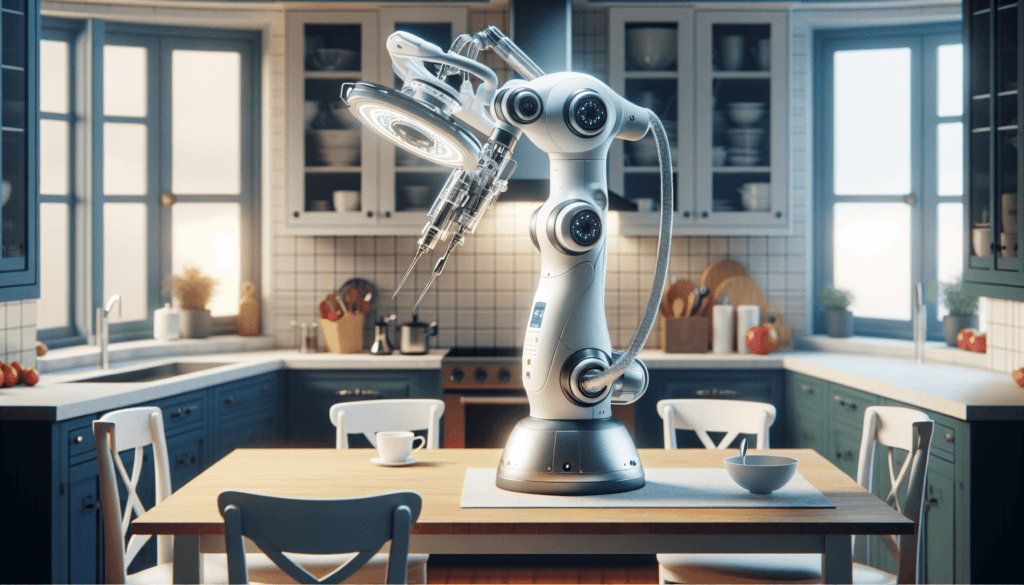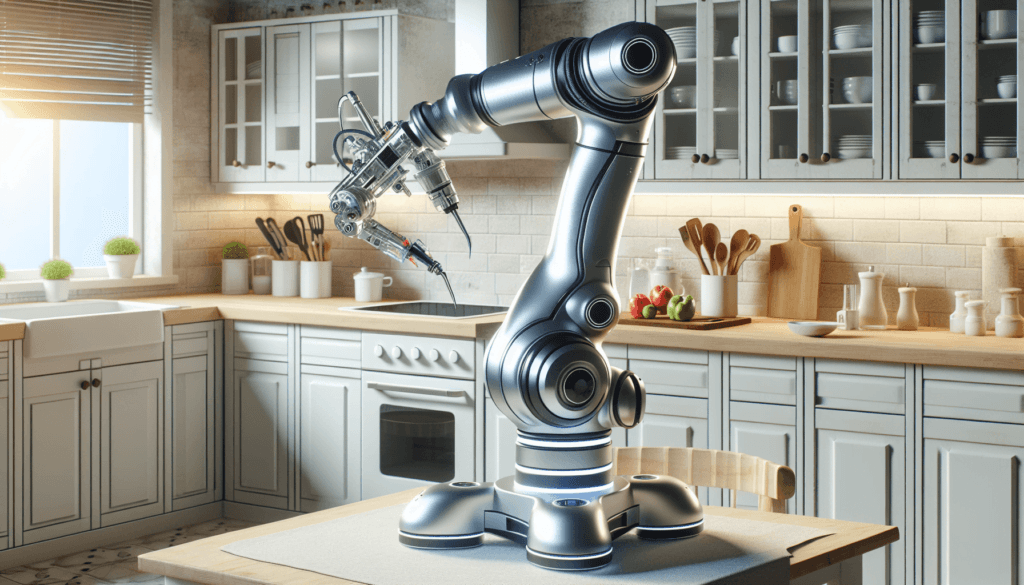In the rapidly advancing landscape of medical technology, “What Are The Prospects For Robot-Assisted Surgery At Home?” delves into the future possibilities and current developments of performing surgical procedures outside traditional clinical settings. Identifying the significant strides in robotic surgery, this article evaluates its potential integration into home healthcare, with a focus on overcoming logistical, ethical, and technical challenges. By providing historical context, examining case studies, and comparing different viewpoints, you will gain a comprehensive understanding of the feasibility and implications of at-home robotic surgeries. Ultimately, this exploration highlights the transformative impact such advancements could have on healthcare accessibility and effectiveness. Have you ever imagined a world where complex surgeries are performed at home by advanced robotic systems? This futuristic scenario is no longer confined to the realm of science fiction but is progressively becoming a potential reality.

This image is property of images.pexels.com.
Table of Contents
Overview
Robot-assisted surgery represents a significant evolution in medical technology, offering precision, efficiency, and reduced recovery times. This innovative technology, which originated in highly controlled environments like hospitals and specialized clinics, is now expanding its horizons. With advancements in robotics, artificial intelligence, and telemedicine, the concept of performing surgeries at the comfort of your own home is tantalizingly close. But what are the realistic prospects for robot-assisted surgery at home?
Thesis Statement
This article explores the potential and challenges of robot-assisted surgery in home environments, analyzing its feasibility, current trends, historical context, and future implications.
Historical Context
Robot-assisted surgery has come a long way since its inception. The first significant milestone was the introduction of the da Vinci Surgical System in 2000, which transformed minimally invasive surgery by allowing surgeons to perform complex procedures with high precision through tiny incisions. Over the past two decades, the evolution of surgical robots has been marked by continuous improvements in technology, increased reliability, and expanded application areas. The historical journey of robot-assisted surgery helps us understand how this technology has matured and sets the stage for contemplating its use at home.
Key Developments in Robot-Assisted Surgery
| Year | Development | Description |
|---|---|---|
| 2000 | da Vinci Surgical System | First widely used robotic surgical system |
| 2011 | Robotically assisted heart surgery | Pioneered less invasive cardiac procedures |
| 2017 | FDA approval of the Senhance System | Introduced haptic feedback in robotic surgery |
| 2019 | Robotic surgeries surpass 10 million globally | Demonstrated the growing acceptance and reliability |
Current Trends
Today, robot-assisted surgery is used for a wide array of procedures, including urology, gynecology, orthopedics, and neurosurgery. One of the most outstanding trends is the integration of AI and machine learning, enhancing the precision and outcomes of these surgeries. Furthermore, the rise of telemedicine and remote surgery capabilities, driven by high-speed internet and 5G technology, has set a precedent for considering robotic surgery outside conventional medical settings.
Innovations Leading the Way
Several innovations signal the transition of robotic surgery from hospital to home:
- Portable Robotic Systems: Miniaturization of robotic systems to make them portable and usable in non-hospital environments.
- AI-Assisted Surgery: Enhanced decision-making support for surgeons through AI, reducing the margin of error.
- Teleoperated Surgery: Surgeons can operate from remote locations, combining robotic systems and telecommunication technology.
Current Trends in Technology and Medicine
| Trend | Impact |
|---|---|
| AI Integration | Improved accuracy and decision making |
| Telemedicine Growth | Increased accessibility to surgical expertise |
| 5G Connectivity | Low latency, enabling real-time remote control of surgical robots |

This image is property of images.pexels.com.
Key Concepts and Definitions
To fully grasp the discussion about robot-assisted surgery at home, understanding a few key concepts is crucial.
Robot-Assisted Surgery
Robot-assisted surgery involves the use of robotic systems to aid surgeons in performing complex procedures with high precision. These systems include robotic arms, cameras, and instruments controlled by the surgeon.
Telemedicine
Telemedicine refers to the practice of delivering medical care remotely using telecommunications technology. In the context of surgery, it involves performing surgical procedures from a distant location.
Artificial Intelligence (AI)
AI in surgery includes algorithms and software that assist in pre-operative planning, intra-operative guidance, and post-operative analysis to improve surgical outcomes.
Detailed Exploration
Given these foundational concepts, let’s delve deeper into the prospects of robot-assisted surgery at home by examining its technical feasibility, safety considerations, regulatory challenges, and implications.
Technical Feasibility
In order to perform surgeries at home, robotic systems need to be not only sophisticated but also user-friendly and portable. This requires significant advancements in robotic engineering, miniaturization, and interface design.
Portable Robotic Systems
Current projects are underway to create compact and portable robotic platforms that can be transported and set up in home environments. These systems would include smaller, lighter robotic arms and more versatile surgical instruments.
Safety Considerations
Safety is paramount when considering home-based robot-assisted surgery. Patients’ homes might not have the same level of sterility and emergency support as hospitals. Therefore, robust protocols and systems need to be in place to ensure patient safety.
Monitoring and Support
Continuous monitoring using IoT devices and immediate support from nearby medical facilities could mitigate some of the safety risks associated with home surgeries. Remote real-time monitoring and intervention capabilities would be essential.
Regulatory Challenges
The regulatory landscape for medical robots is complex. Bringing robot-assisted surgery into homes would involve stringent assessments by regulatory bodies like the FDA and the European Medicines Agency (EMA).
Compliance and Standards
Meeting regulatory standards requires ensuring that robotic systems used in homes are compliant with medical device regulations, safety standards, and ethical guidelines. This includes rigorous testing and validation phases.
Example 1: RAS in Telehealth
In a notable case, surgeons in China performed the world’s first remote robot-assisted brain surgery using 5G technology. The patient was over 3,000 kilometers away from the surgeon. This precedent not only validates the technical feasibility of remote surgeries but also highlights the potential for extending such capabilities to home environments.
Example 2: Portable Surgery Pods
Another application involves the development of portable surgery pods. These self-contained, sterile environments can be deployed to patients’ homes, ensuring that the surgical field remains uncontaminated. Parachuting these pods to remote or disaster-stricken areas showcases their versatility and the potential for home use.

This image is property of images.pexels.com.
Comparison of Different Perspectives
The debate on home-based robot-assisted surgery reveals varying opinions within the medical and technological communities.
Advocates’ Perspective
Proponents argue that home-based surgeries can drastically reduce healthcare costs, increase convenience for patients, and improve access to specialized surgical care in remote areas. They believe that with proper safeguards, the risks can be managed effectively.
Critics’ Perspective
Opponents caution against the myriad risks, including potential technical failures, compromised patient safety, and legal liabilities. They emphasize that the controlled environment of a hospital is irreplaceable and that home settings cannot match the sterility and support systems of medical facilities.
Impact Assessment
Assessing the impact of home-based robot-assisted surgery involves examining these differing perspectives and weighing their implications.
Benefits
- Cost Reduction: Reducing hospital stay costs and transportation expenses.
- Accessibility: Extending surgical care to underserved and remote populations.
- Convenience: Minimizing disruption to the patient’s life and facilitating quicker recovery times.
Risks
- Technical Failures: Risks of unplanned downtimes or malfunctions.
- Safety Concerns: Challenges in maintaining sterile environments and responding to emergencies.

Future Directions and Implications
As we look towards the future, several promising directions and implications come into focus.
Predictions
- Integrated Home Healthcare Systems: Homes may be equipped with advanced healthcare systems, including robotic surgery devices, smart monitoring tools, and emergency response protocols.
- Evolution of Telemedicine: The growth of telemedicine will enable seamless integration of robotic surgery into remote care strategies, making it more feasible and reliable.
Broader Implications
- Healthcare Industry: Could revolutionize the healthcare delivery model, emphasizing home-based care.
- Society: Enhancing quality of life by making complex medical procedures more accessible and less disruptive.
Conclusion
Recap
In summary, robot-assisted surgery at home is an evolving concept backed by significant technological advancements, current trends, and innovative applications. While technical and safety challenges persist, the potential benefits for reducing costs, enhancing accessibility, and increasing patient convenience are substantial.
Final Thought
As you ponder the future of health care, consider the immense potential robot-assisted home surgery offers. Will your next surgery be performed by a robot in your living room?

Engagement
Your thoughts and perspectives are invaluable. Share your comments and questions below, and explore further resources on this groundbreaking topic.
Credible Sources
- Intuitive Surgical Inc. “da Vinci Surgery.” Accessed March 2023.
- FDA. “Medical Devices.” U.S. Food & Drug Administration.
- Jiang, Tingting, et al. “Remote Robot-Assisted Surgery and 5G Networks in China.” Journal of Neurosurgery, 2022.
